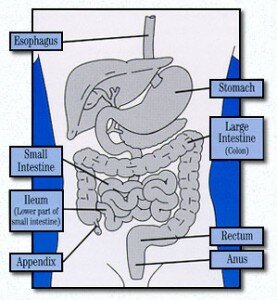Bowel continence
The human body is designed to rid itself of waste products. If we do not rid ourselves of waste material we can become very ill. The organs which help our body cleanse itself of waste are part of the lower digestive system and are often called the ‘bowels’.
How the bowel system works
The bowel consists of the small intestine, the large intestine, the rectum, internal and external anal sphincters and the anal canal. The large intestine (the colon) stores the waste material in liquid form and moves it along towards the rectum by a series of waves and contractions known as peristalsis. While the faeces is in the colon, excess water is removed from it until it forms the consistency of a stool. The internal anal sphincter located below the rectum, opens automatically when it senses that there are faeces in the rectum. Nerves located in the anal canal send a message to the brain that a bowel movement is required. When it is convenient the brain tells the external sphincter to relax and the rectum and stomach muscles to contract. The faeces is then discharged from the body. We usually learn to control this process between the ages of one and three.
How spina bifida affects the bowel
Almost all people born with spina bifida have bowel problems. As with most of the conditions associated with spina bifida, bowel problems are a result of damaged nerves at the bottom of the spinal cord. Nerve damage generally affects three areas of the bowel:
- the external anal sphincter
- the sensory mechanism which tells the brain that the rectum is full and
- the muscles which move the faeces along the colon and out of the body.
In a normally operating bowel the external sphincter will contract when the rectum is full and hold the faeces in the anal canal. However, because there is little or no control over the external anal sphincter for a person with spina bifida, faeces can be discharged or flow from the body unexpectedly.
The interrupted nerve supply to the colon also means that the liquid faeces does not progress as quickly through the colon as it normally would. The longer time spent in the colon leads to more water than usual being extracted from the faeces, turning it into a very hard consistency and leading to constipation.
Even though a person is constipated, the liquid faeces moving into the top of the colon can work its way past the large dry faecal mass and leak out. This ‘overflow diarrhoea’ makes it appear that the person is not constipated at all. This type of diarrhoea is common for people with spina bifida and when it happens, the person should be checked for constipation.
How bowel continence is managed
- A high fibre diet with plenty of water and fluids
- Medication to soften the stools
- A toilet timing and training program The key is REGULARITY.
- Enemas eg bowel washout with Microlax
- Manual evacuation (gloving)
- Exercise
- Surgical procedures such as the Mitrofanoff for Antegrade Colonic Enema (MACE) enables an enema to be given from above the faeces.
The overall aims of bowel management programs are:
- Overall good health
- Confidence in the reliability of one’s bowel management strategies
- Dignity and full social integration
Bowel and bladder continence at school
The child with spina bifida will probably have some problem with continence and will need:
1. Suitable toilet facilities:
2. Wheelchair access (if necessary)
3. Sink, cupboard and bin in toilet
4. A clean toilet area
5. Privacy
6. Aide time for supervision or assistance with catheterisation.
7. Extra time for toileting
8. An established toilet routine
9. To deal with accidents
10. A change of clothes
11. To clean their wheelchair
12. To wash out soiled clothes
13. To be told they have had an accident, as children are not always aware of the situation.
14. To inform the teacher if there is a change of continence management procedures.
15. To drink regularly to minimise urinary tract infections.
The system that is in place should always maintain the dignity of the child.
An explanation of some terms
Bladder augmentation – A surgical procedure in which a section of the bowel is taken and sewn onto a surgically created opening in the bladder to increase its capacity.
Perineal urethrostomy – The creation of an opening for the urethra in the perineum for ease of catheterisation.
Artificial urinary sphincter – A surgical procedure in which a small fluid filled cuff is placed around the neck of the urethra. A pump is also inserted which when activated, releases the pressure of the cuff allowing urine to flow.
MACE (or ACE) – The creation of a stoma (opening) for easy access into the caecum or top of the large bowel in order to irrigate (wash out) the bowel. The appendix is often used as the duct between the opening and the bowel.
Megacolon – An overstretched piece of bowel resulting from the accumulation of too much dry hard faeces.
